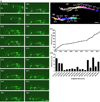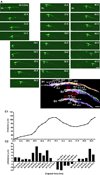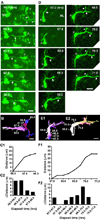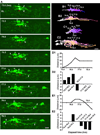Four distinct phases of basket/stellate cell migration after entering their final destination (the molecular layer) in the developing cerebellum
- PMID: 19500566
- PMCID: PMC2718556
- DOI: 10.1016/j.ydbio.2009.05.575
Four distinct phases of basket/stellate cell migration after entering their final destination (the molecular layer) in the developing cerebellum
Abstract
In the adult cerebellum, basket/stellate cells are scattered throughout the ML, but little is known about the process underlying the cell dispersion. To determine the allocation of stellate/basket cells within the ML, we examined their migration in the early postnatal mouse cerebellum. We found that after entering the ML, basket/stellate cells sequentially exhibit four distinct phases of migration. First, the cells migrated radially from the bottom to the top while exhibiting saltatory movement with a single leading process (Phase I). Second, the cells turned at the top and migrated tangentially in a rostro-caudal direction, with an occasional reversal of the direction of migration (Phase II). Third, the cells turned and migrated radially within the ML at a significantly reduced speed while repeatedly extending and withdrawing the leading processes (Phase III). Fourth, the cells turned at the middle and migrated tangentially at their slowest speed, while extending several dendrite-like processes after having completely withdrawn the leading process (Phase IV). Finally, the cells stopped and completed their migration. These results suggest that the dispersion of basket/stellate cells in the ML is controlled by the orchestrated activity of external guidance cues, cell-cell contact and intrinsic programs in a position- and time-dependent manner.
Figures











Similar articles
-
Intrinsic program for migration of cerebellar granule cells in vitro.J Neurosci. 2002 Jul 15;22(14):5966-81. doi: 10.1523/JNEUROSCI.22-14-05966.2002. J Neurosci. 2002. PMID: 12122059 Free PMC article.
-
Autonomous turning of cerebellar granule cells in vitro by intrinsic programs.Dev Biol. 2009 Feb 1;326(1):237-49. doi: 10.1016/j.ydbio.2008.11.012. Epub 2008 Nov 28. Dev Biol. 2009. PMID: 19063877 Free PMC article.
-
Close homologue of adhesion molecule L1 promotes survival of Purkinje and granule cells and granule cell migration during murine cerebellar development.J Comp Neurol. 2009 Apr 10;513(5):496-510. doi: 10.1002/cne.21981. J Comp Neurol. 2009. PMID: 19226508
-
Recent advances in cerebellar granule cell migration.Cell Mol Life Sci. 2003 Jun;60(6):1084-98. doi: 10.1007/s00018-003-2248-z. Cell Mol Life Sci. 2003. PMID: 12861377 Free PMC article. Review.
-
Biochemistry of granule cell migration in developing mouse cerebellum.Prog Clin Biol Res. 1982;85 Pt B:509-19. Prog Clin Biol Res. 1982. PMID: 6750635 Review. No abstract available.
Cited by
-
Compromised Survival of Cerebellar Molecular Layer Interneurons Lacking GDNF Receptors GFRα1 or RET Impairs Normal Cerebellar Motor Learning.Cell Rep. 2017 Jun 6;19(10):1977-1986. doi: 10.1016/j.celrep.2017.05.030. Cell Rep. 2017. PMID: 28591570 Free PMC article.
-
Morphological pseudotime ordering and fate mapping reveal diversification of cerebellar inhibitory interneurons.Nat Commun. 2022 Jun 14;13(1):3433. doi: 10.1038/s41467-022-30977-2. Nat Commun. 2022. PMID: 35701402 Free PMC article.
-
Postnatal Migration of Cerebellar Interneurons.Brain Sci. 2017 Jun 6;7(6):62. doi: 10.3390/brainsci7060062. Brain Sci. 2017. PMID: 28587295 Free PMC article. Review.
-
Regulation of cerebellar network development by granule cells and their molecules.Front Mol Neurosci. 2023 Jul 14;16:1236015. doi: 10.3389/fnmol.2023.1236015. eCollection 2023. Front Mol Neurosci. 2023. PMID: 37520428 Free PMC article. Review.
-
From migration to settlement: the pathways, migration modes and dynamics of neurons in the developing brain.Proc Jpn Acad Ser B Phys Biol Sci. 2016;92(1):1-19. doi: 10.2183/pjab.92.1. Proc Jpn Acad Ser B Phys Biol Sci. 2016. PMID: 26755396 Free PMC article. Review.
References
-
- Adams NC, Tomoda T, Cooper M, Dietz G, Hatten ME. Mice that lack astrotactin have slowed neuronal migration. Development. 2002;129:965–972. - PubMed
-
- Altman J. Postnatal development of the cerebellar cortex in the rat. I. The external germinal layer and the transitional molecular layer. J. Comp. Neurol. 1972a;145:353–359. - PubMed
-
- Altman J. Postnatal development of the cerebellar cortex in the rat. II. Phases in the maturation of Purkinje cells and of the molecular layer. J. Comp. Neurol. 1972b;145:399–463. - PubMed
-
- Anderson SA, Marin O, Horn C, Jennings K, Rubenstein JLR. Distinct cortical migrations from the medial and lateral ganglionic eminences. Development. 2001;128:353–363. - PubMed
Publication types
MeSH terms
Grants and funding
LinkOut - more resources
Full Text Sources

